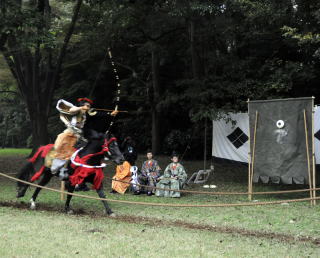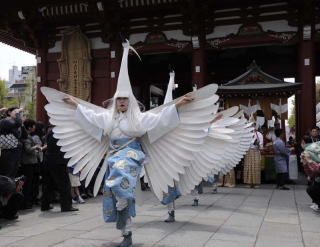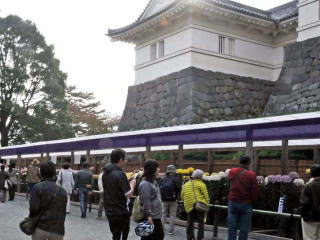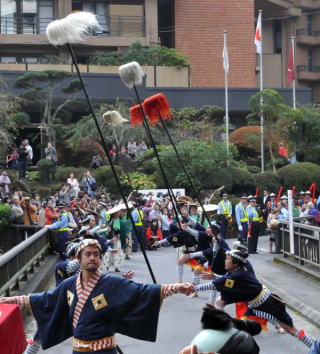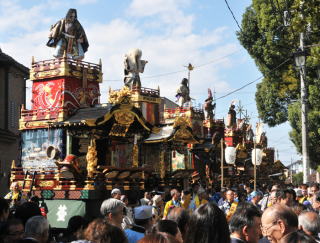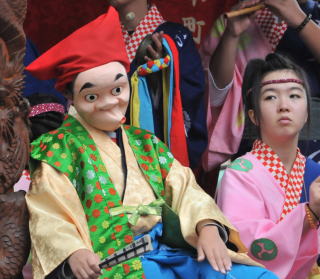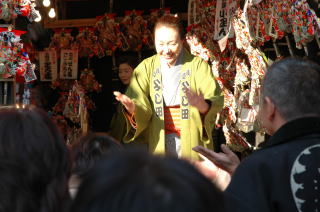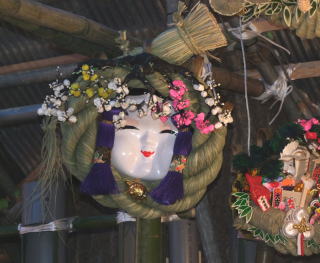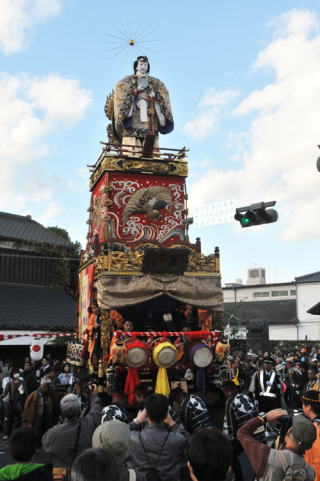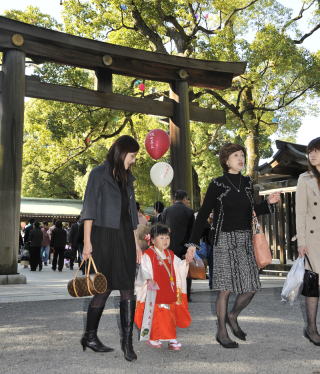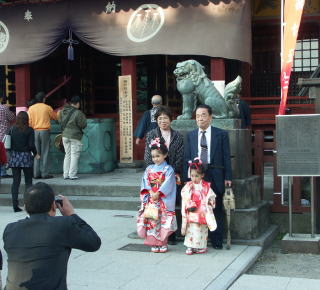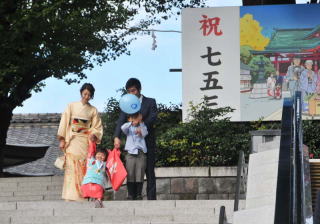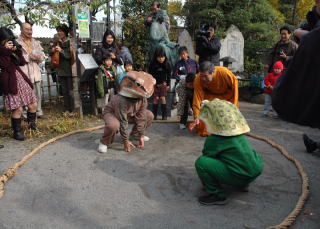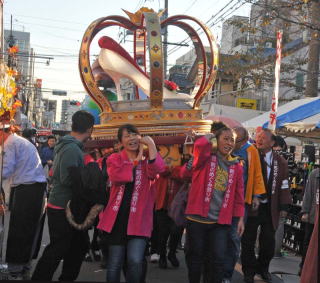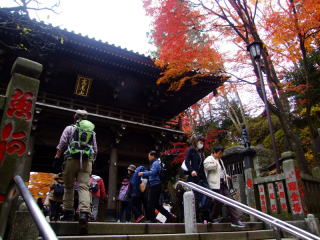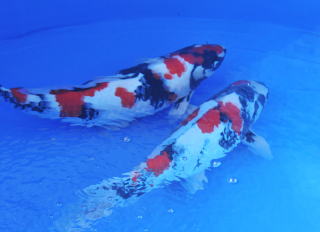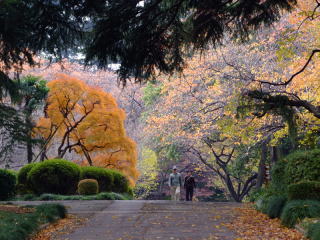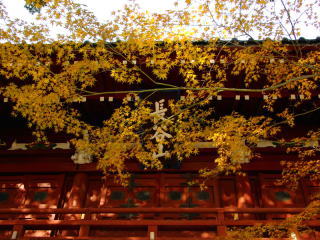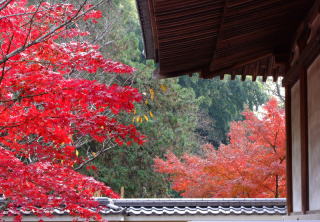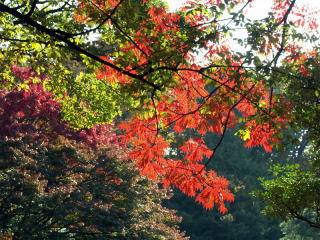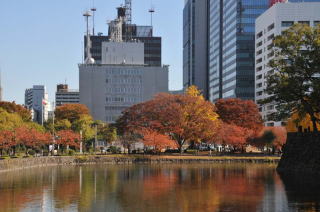NOVEMBER 2025
All the schedules listed below are subject to change.
Please confirm dates and time at the phone numbers listed before you go.
| (*) covered events |
AUTUMN GARDENS
(Late November to Early December)
| Meiji Jingu Shrine Autumn Grand Festival. Nov. 1, 2 and 3 Various events are held preceding the official day of the festival days. Meiji Shrine in Yoyogi, Shibuya-ku The shrine is dedicated to the momory of the Emperor Meiji and his wife Empress Shoken. The shrine was built on November 1, 1920 after Emperor Meiji passed away in 1912 and his wife in 1914. Nov. 3 is the birthday of Emperor Meiji. The following are events for the year 2025 Oct.25 through Nov. 23, Chrysanthemum exhibition at the front approach to the shrine. Nov. 1, Noh and Kyogen from 12 noon/ Sankyoku (koto, shamisen and shakuhachi) from 3:45 p.m. Nov. 2, Bugaku (ancient ceremonial dance and music shown in picture) from 11 a.m., Hogaku and Hobu (Japanese traditional music and dance) from 2:45 p.m. Nov. 3, Kyudo (archery) and Aikido at 9 a.m., Kobudo (Japanes old martial arts) at 10 a.m., Momoteshiki (Japanese ritual archery) at 11 a.m. Yabusame (horseback archery) at 1 p.m Meiji Jingu Shrine Address: 1-1 Kamizono-cho, Yoyogi, Shibuya-ku Access: Harajuku Station on JR Yamanote Line and Meiji Jingue Mae Station on Subway Chiyoda Line Map: http://goo.gl/maps/qrH1t Telephone: 03-3379-5511 |
 |
|
| more photos |
| Hibiya Park Chrysanthemum Exhibition Oct. 31-Nov. 9 in 2025. Time: 10 a.m.-4 p.m. Place: Hibiya Park in Chiyoda-ku The Chrysanthemum exhibition at Hibiya Park has a long history since 1914. The exhibition is one of the largest and known for its high standard. About 2,000 items are displayed. Chrysanthemum (kiku) which originally came from China was extensively cultivated in Japan and surpassed far in beauty than the chrysanthemum in China. During the early days of the Tokugawa Shogunate, Kiku became immensely popular among the feudal lords and they took up the culture of this flower as their hobby. The 16 petalled chrysanthemum is the emblem of the Imperial Family. Growing chrysanthemum can only be achieved successfully with the utmost care and patience and above everything else, thoroughness. The giant kiku, some of which have hundreds of branches, grows from a single root and they are wired for perfect shapes. Access: Hibiya Station on Subways Chiyoda Line and Hibiya Line Telephone: 03-5320-4768 |
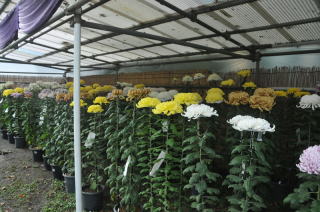 |
|
| more photos |
| Yoogo Kikka Taikai (Chrysanthemum Exhibition) Zenyoji Temple in Koiwa, Edogawa-ku Yoogo means "descending god." Oct. 20-Nov. 23, 2025(Best time to see in November) Zenyoji Temple in Koiwa is a temple of Buzan sect of Shingon buddhism and is also known as Koiwa Fudoson. The temple is believed to be founded in 1527 A large miniature landscape created by chrysanthemum flowers is modeling famous sceneries of "Fall of Nachi" in Wakayama Prefecture. Theme changes every year. Zenyoji Temple is known for its giant pine tree called "Yoogo no Matsu" (god descended pine tree) which is estimated to be 600 years old. The tree was designated as the natural monument of Tokyo in 1926 and the natural monument of Japan in 2011. The tree is 8 meters high and branches extend horizontally about 30 meters in diameter. The tree vied its largeness with "Okano Matsu" at Shinkakuji Temple in Sanuki, Kagawa Prefecture before but the "Okano Matsu" died in 1993. Access: 2 minutes walk from Edogawa Hospital bus stop of Keisei Bus from JR Koiwa Station Telephone: 03-3652-1151 (Edogawa Ward Office)/ 03-3657-6692 (Zenyoji Temple) |
 |
|
| more photos |
| IRUMA BASE FESTIVAL Nov. 3, 9 a.m.-3 p.m. (Every year the same day of the month) Iruma, Saitama Prefecture Iruma Air Base is located in the north west of Tokyo covering parts of Iruma City and Sayama City of Saitama Prefecture. Close to the base, Seibu Railroad's Ikebukuro Line runs and it is 40 to 50 minutes by train from the central Tokyo. The air base is in charge of air defense of Tokyo metropolitan area, Chubu Nagoya area and Osaka covering a large air space of mainland Japan. 18 troops and about 4,300 people are stationed at the base. Iruma plays an important role of logistics. The base keeps 50 aircrafts mostly for transports and does not have fighters. The transport aircrafts here carry about 85,000 people a year and fly supplies of 2,500 tons. The base also has a command of air rescue squadrons assisting and supporting people in natural disasters in the country. Before the war, at the Iruma airfield, the Imperial Japanese Army Air Force Academy was located and was used for training. After the war, U.S. Air Force used the base renaming as Johnson Air Base. The base was returned to Japan in 1958 to Japan Air Self Defence Force. Iruma Air Base is today known widely among Japanese people as a base where JASDF's aviation team Blue Impulse performs acrobatic flights at the base festival on November 3. This year festival in 2016 is 48th and in 2015, the festival attracted 240,000 visitors in one day. Displayed aircrafts are: C-1, U-4, T-4, U-125, YS-11FC, CH-47J, F-15J, F-2, U125A, UH-60J , T-7, T-400, C130H, AH-1S, OH-6, UH-1, SH-60J, C-12, UH-1 URL: iruma air basebhqČ [JASDF] qóŠqŕ (mod.go.jp) Access: Inariyama Koen Station on Seibu Ikeburo Line Telephone: 04-2953-6131 (Iruma Base Public Relations) |
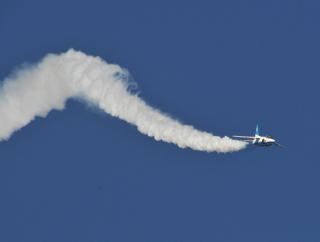 |
|
| more photos |
| "Dream Yosakoi" Nov. 2 and 3, 2025 at Odaiba and Marunouchi. Today, Yosakoi dance is widely known in the nation but it's history is short. In 1954, people of Kochi with a purpose of promoting the city came up with Yosakoi dance which is a modern version of Awa Odori (a traditional summer dance of Tokushima - neighboring prefectures of Kochi in Shikoku). The energetic dance - combination of traditional Japanese dance and modern music did not take time to attract people's attentions and has become a popular event since. The choreographed dances are performed by large teams. Styles of dance are free. Only common thing is the uses of "naruko" small wooden castanets in the hands of dancers. Naruko were used in Kochi to scare birds away from rice fields in the old time. The costumes used are widely varied by teams. http://www.dreamyosacoy.jp/ Address: 2-Chome, Daiba, Minato-ku Access: Odaiba Kaihin Koen Station on Yurikamome from Shinbashi. Map: http://goo.gl/maps/MLVho Telephone: Unavailable |
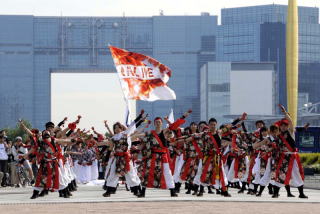 |
|
| more photos |
| Autumn Roses (Oct. and Nov.) at Yatsu Rose Garden - The original Yatsu Rose Garden was owned by Keisei Electric Railways
as a part of Yatsu Leasure Park. The park's rose garden was famous from
that time as the largest of its kind in the orient. The garden was closed
in 1982 as the comapny shifted its leasure business to Tokyo Disney Land.
The rose garden was remodeled and reopend in 1988 to answer citizens requests
by Narashino City. A large rose garden (about 3 acres) houses more than 700 varieties and 6300 bushes of roses from all over the world. The rose garden is located close to the Tokyo Bay and The Yatsu Higata (tidal flat) Observation Center with a dimension of 1,000 acres is adjacent to the rose garden. A great number of creatures inhabit here such as lugworms, shells, crabs, fish and water-birds including shorebirds. URL: Yatsu Rose Garden Admission (Rose Garden): 360 yen (May 1 through Nov. 15) Open 9 a.m. to 6 p.m. Closed on Monday (open all day during May and June, and Oct 1 through Nov. 5) Address: 3-1-14 Yatsu, Narashino City, Chiba Prefecture. Access: Yatsu Station on Keisei Line from Ueno. 5 minutes walk. Map: http://goo.gl/maps/EieBO Telephone: 047-453-3772 (Photos taken Nov. 6) |
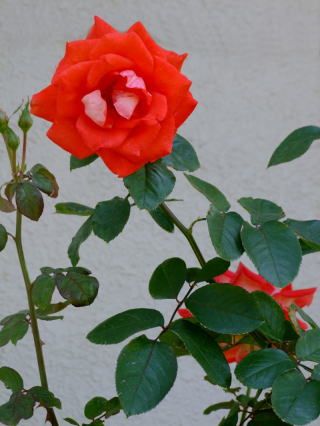 |
|
| more photos |

